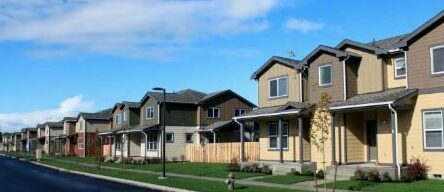The main goals for this study include:
- Identifying opportunities for collaboration and potential barriers to active duty service members access to adequate affordable housing near JBLM.
- Identifying opportunities for collaboration to incentivize homeowners, landlords, and property managers that could offer their properties to military families.
- Identifying how off-base housing availability and development can best contribute to lowering the backlog of military family housing need.
Quality affordable housing around JBLM is limited while the demand for housing increases due to the continued growth in South Puget Sound. The critical question is how off-base housing availability and development best contribute to lowering the backlog of military family housing needs. On-base housing remains constant at 5,159 units which are habitually 97% occupied, producing a 1,000+ on-base housing waitlist. With 71% of the active duty force and 87% of the JBLM workforce living off-base in JBLM’s surrounding communities, this assessment is very much needed.
This planning study is intended to document the specific purpose and need for increased cooperation and improved processes for communications to develop and identify various housing options. Due to rapidly appreciating market conditions, increasing rental rates, and rising mortgage interest rates, the consultant team will update the 2020 SSMCP Housing Study. The previous SSMCP Housing Study completed in 2020 used 2018 and 2019 data – conditions before the global Pandemic.
Matrix Design Group will also assess two conflicting housing studies (the 2020 SSMCP Housing Study and the 2020Army Housing Market Analysis (HMA)). The Army HMA is used to determine if additional on-base housing is needed. The Army HMA found a decreasing need for military family housing, from 3,021 in 2020 to only 245 in 2025. Conversely, the SSMCP Housing Study found population is projected to grow significantly in the JBLM Study Area between 2020 and 2040. Approximately 113,000 new off-base housing units are needed in the JBLM Area to accommodate projected growth by 2040. This illustrates an increasing rather than decreasing housing need. This dichotomy must be better analyzed and understood.
To reflect the complexity of the needed study area, a wide array of partners are involved in the process, including but not limited to:
- JBLM Headquarters and staff
- DoD
- Washington State Department of Commerce
- Nisqually Indian Tribe
- Thurston Regional Planning Council (TRPC)
- Pierce County
- Thurston County
- City of DuPont
- City of Lacey
- City of Lakewood
- City of Rainier
- City of Roy
- Town of Steilacoom
- City of Tacoma
- Tacoma-Pierce County Chamber
- Thurston County Chamber
- Tacoma-Pierce County Health Department
- City of Yelm

